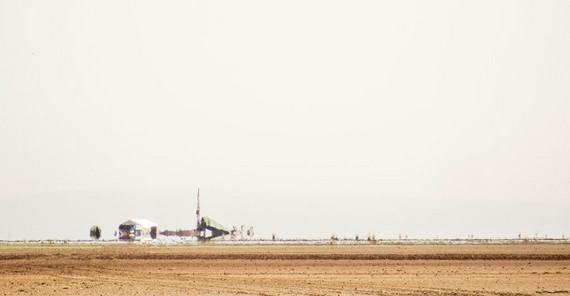The project, led by Prof. Martin H. Trauth together with colleagues from the Universities of Cologne, Aberystwyth and Addis Ababa, and funded by the German Research Foundation, among others, explores the youngest chapter in human evolution by analysing lacustrine sediments in close vicinity to paleo-anthropological key sites in eastern Africa using scientific deep drilling. The study presented by Dr. Verena Foerster (University of Cologne) included more than 22 researchers from 19 institutions in six countries. Three distinct phases of climate variability in eastern Africa coincided with shifts in hominin evolution and dispersal over the last 620,000 years, an analysis of environmental proxies from a lake sediment record has revealed.
An interdisciplinary team including geoscientists, paleontologists, archaeologists, evolutionary anthropologists, and climate modellers worked towards recovering two 280 m long sediment cores, from which so-called proxies (like microfossils or elemental variations) were used to glean data to reconstruct the region’s climate history. They identified phases of climatic stress as well as more favourable conditions and interpreted how these factors changed human habitats, influencing human biological and cultural evolution as well as their dispersal.
Specifically, the scientists found that various anatomically diverse hominin groups inhabited the area during a phase of long-lasting and relatively stable humid conditions from approximately 620,000 to 275,000 years before present. However, a series of shorter abrupt and extreme arid pulses interrupted this long generally stable and wet phase. Most likely, this resulted in a fragmentation of habitats, shifts in population dynamics and even the extinctions of local populations. As a result, small, reproductively and culturally isolated populations then had to adapt to dramatically transformed local environments, likely stimulating the appearance of the many geographically and anatomically distinct hominin groups and the separation of our modern human ancestors from archaic groups.
A phase with significant climate swings resulting in regularly transformed habitats in the area from approximately 275,000 to 60,000 years before present repeatedly resulted in environmental shifts from lush vegetation with deep fresh water lakes to highly arid landscapes. In this phase, the population groups gradually transitioned from Acheulean technologies to more sophisticated Middle Stone Age technologies. This crucial phase also encompasses the emergence of Homo sapiens in eastern Africa as well as key human social, technological, and cultural innovations. “These innovations, such as more varied toolkits and long-distance transport, would have equipped modern humans with an unprecedented adaptability to the repeated expansions and contractions of habitats,” said Dr. Foerster, the paper’s lead author.
The phase from approximately 60,000 to 10,000 years before present saw the most extreme environmental fluctuations, but also the most arid phase of the entire record, which could have acted as a motor for continuous indigenous cultural change. The scientists believe that the brief alignment of humid pulses in eastern Africa with wet phases in north-eastern Africa and the Mediterranean was key to opening favourable migration routes out of Africa, facilitating the global dispersal of Homo sapiens. “In view of current threats to the human habitat from climate change and the overuse of natural resources through human activity, understanding how the relationship between climate and human evolution has become more relevant than ever,” Foerster concluded.
Link to Publication: Verena Foerster, Asfawossen Asrat, Christopher Bronk Ramsey, Erik T. Brown, Melissa S. Chapot, Alan Deino, Walter Duesing, Matthew Grove, Annette Hahn, Annett Junginger, Stefanie Kaboth-Bahr, Christine S. Lane, Stephan Opitz, Anders Noren, Helen M. Roberts, Mona Stockhecke, Ralph Tiedemann, Céline M. Vidal, Ralf Vogelsang, Andrew S. Cohen, Henry F. Lamb, Frank Schaebitz and Martin H. Trauth: Pleistocene climate variability in eastern Africa influenced hominin evolution, Nature Geoscience, DOI: 10.1038/s41561-022-01032-y.
https://www.nature.com/articles/s41561-022-01032-y
Link to Full Press Release Köln University: https://portal.uni-koeln.de/en/universitaet/aktuell/press-releases/single-news/key-phases-of-human-evolution-coincide-with-flickers-in-eastern-africas-climate
Image: Coring site and camp in the Chew Bahir basin in southern Ethiopia. Image Credit: Annett Junginger.
Contact University of Potsdam: Prof. Dr. Martin H. Trauth
E-Mail: trauthugeo.uni-potsdampde
Phone: +49 331 977 5810 / 2116
Contact University of Cologne: Dr. Verena Foerster, E-Mail: V.Foersteruuni-koelnpde
Media Information 27-09-2022 / No. 103

